The Konark Sun Temple, a magnificent masterpiece of ancient Indian architecture, stands as a testament to the grandeur and artistic brilliance of the past. Located in the state of Odisha, India, this awe-inspiring temple is renowned worldwide for its intricate stone carvings, colossal chariot-like structure, and its symbolic representation of the celestial journey of the Sun God.
With a rich history, deep symbolism, and captivating design, the Konark Sun Temple continues to captivate visitors, offering a glimpse into the rich cultural heritage of India and leaving them in awe of the remarkable craftsmanship of its creators.
In this article, we will cover some of the most interesting facts about the Konark Sun Temple, along with its story and history.
The Konark Sun Temple
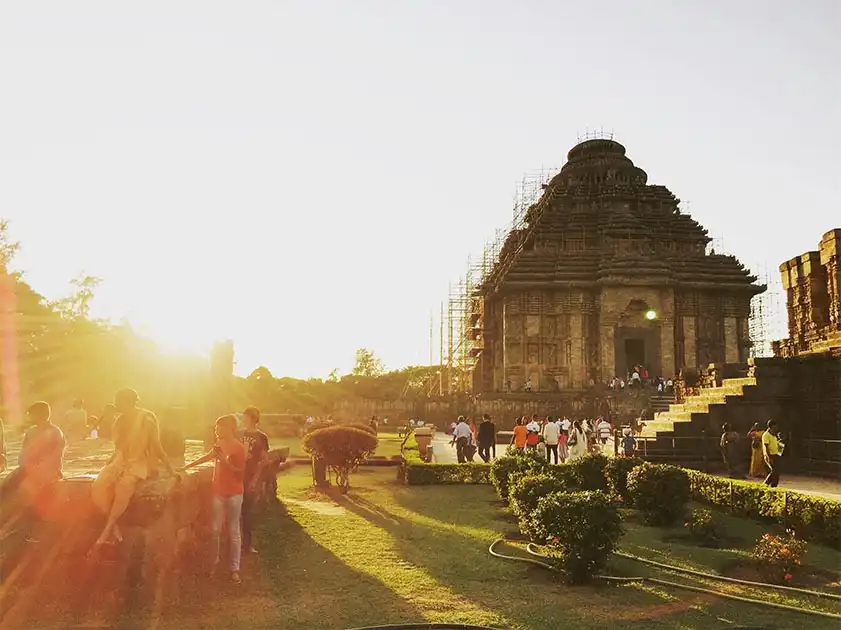
The Konark Sun Temple, also known as the Black Pagoda, is a famous Hindu temple located in Konark, Odisha, India. It is one of India’s most stunning architectural marvels and is dedicated to the Sun God, Surya.
The history of the Konark Sun Temple dates back to the 13th century during the reign of King Narasimhadeva I of the Eastern Ganga Dynasty. The construction of the temple began around 1240 CE and is believed to have taken about 12 years to complete.
The temple was dedicated to the Sun God, Surya, and served as a place of worship and pilgrimage. It was designed as a grand architectural masterpiece, reflecting the artistic and architectural skills of the time. The temple’s location near the coast of Odisha was strategically chosen, emphasizing the importance of the Sun God in maritime activities, trade, and navigation.
The reign of King Narasimhadeva I was considered a golden age for the Eastern Ganga Dynasty. He was a patron of art, culture, and architecture, and the construction of the Konark Sun Temple was a testament to his grand vision.
Over the centuries, the temple faced numerous challenges, including invasions, natural disasters, and neglect. The decline of the Eastern Ganga Dynasty and shifting political powers in the region led to the temple’s gradual abandonment.
During the 16th and 17th centuries, the Konark Sun Temple faced repeated attacks and invasions by Islamic armies, resulting in significant damage. The temple was believed to be partially dismantled and its sculptures defaced during these conflicts.
In the 18th century, the Marathas took control of Odisha and began efforts to preserve the temple. However, by this time, the temple was already in ruins, with only the main sanctum and the dance hall remaining intact.
During the British colonial period, extensive restoration work was undertaken by archaeologists and architects to stabilize the remaining structure and preserve its architectural significance. Several sculptures and parts of the temple were relocated to museums for protection.
In 1984, the Konark Sun Temple was designated as a UNESCO World Heritage Site in recognition of its exceptional universal value as a cultural and architectural masterpiece. It continues to attract tourists and scholars from around the world, fascinated by its intricate carvings, architectural splendor, and historical significance.
Today, although the temple is in a state of ruins, it remains a symbol of Odisha’s rich cultural heritage and is an important pilgrimage site for devotees of Surya, the Sun God. The temple complex and its sculptures provide valuable insights into the artistic and architectural achievements of ancient India.
The Story of Konark Temple
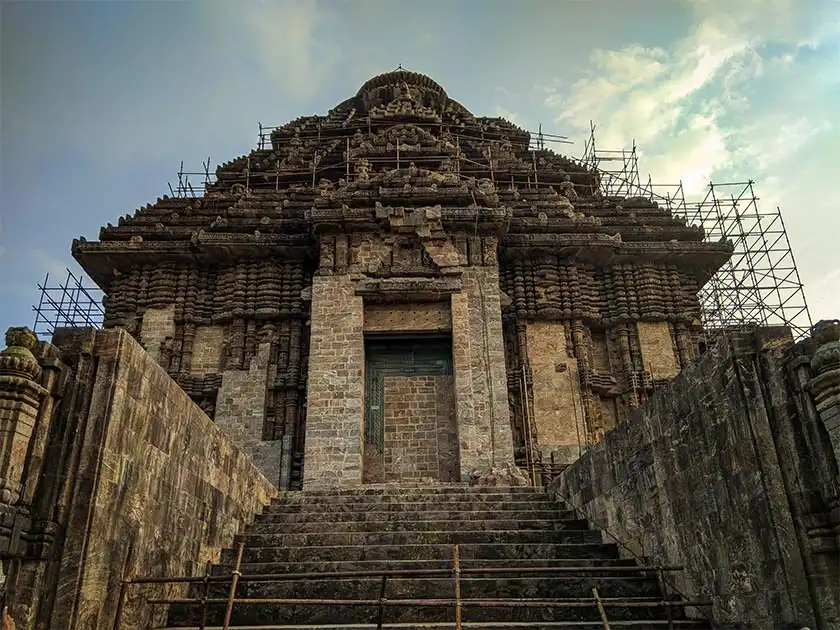
The story of the Konark Temple has a mix of historical accounts and legends surrounding its construction. Here is a popular legend associated with the temple:
Legend of Samba and Lord Krishna
According to a popular legend, the construction of the Konark Temple was initiated by Samba, the son of Lord Krishna. Samba was cursed with leprosy, and in order to seek a cure, he performed severe penance to please the Sun God, Surya.
Pleased with his devotion, Surya appeared before Samba and granted him a boon. Samba asked to be cured of his leprosy, and Surya instructed him to build a grand temple in his honor.
Construction Challenges
Samba began the construction of the temple, but he faced several challenges. The temple’s construction was so grand and intricate that it required the work of thousands of skilled craftsmen and laborers. However, the temple’s construction was not progressing smoothly.
It is said that the temple’s completion was contingent upon Samba’s marriage to a princess named Chandrabhaga, who possessed extraordinary powers.
Divine Intervention
Samba found Chandrabhaga, and they got married. According to the legend, Chandrabhaga possessed mystical powers and used her abilities to protect the temple from any further obstacles. However, Samba’s pride grew, and he began to believe that he alone was responsible for the temple’s construction, neglecting the contributions of the artisans and laborers. This angered the gods, and they decided to teach Samba a lesson.
Destruction of the Temple
As a punishment for his arrogance, Samba was cursed with a severe illness, and the gods decided to destroy the temple. It is said that the structure was never completed, and the idols inside the temple were hidden away to protect them.
The temple fell into ruins over the centuries due to natural causes, including the effects of time, invasions, and neglect.
While this legend adds a mythical touch to the story of the Konark Temple, it’s important to note that historical records and archaeological findings are also crucial in understanding the temple’s construction, architectural brilliance, and subsequent decline.
The temple stands as a testament to the architectural prowess and cultural heritage of ancient India.
Facts about the Konark Sun Temple
Discover the mesmerizing world of the Konark Sun Temple, an architectural masterpiece nestled in the heart of Odisha, India. Embark on a journey through time as we delve into the amazing facts about the Konark Sun Temple temple.
1. The Konark Sun Temple was Built in the 13th Century
The Konark Sun Temple was built in the 13th century during the reign of King Narasimhadeva I of the Eastern Ganga Dynasty. It is designed in the form of a gigantic chariot with intricately carved stone wheels, horses, and various mythical figures.
The Konark Sun Temple is considered one of the most remarkable architectural achievements of ancient India. Its intricate and elaborate stone carvings, colossal structure, and innovative design continue to awe visitors to this day.
2. Sun Dial Effect
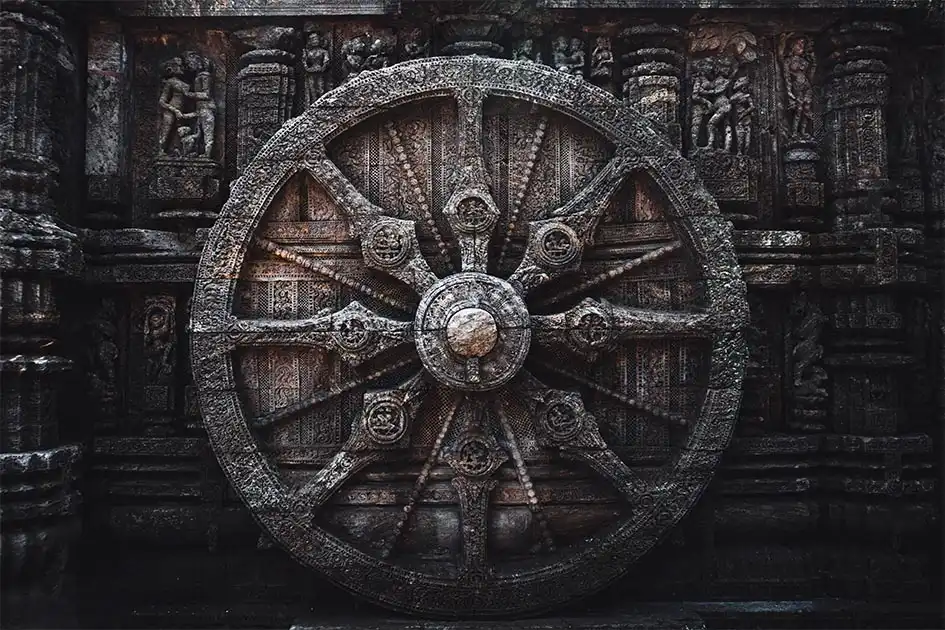
The temple is designed in such a way that it acts as a giant sundial. The position of the temple and the intricate carvings allow accurate timekeeping, with the shadow of the main tower falling on specific carved panels to indicate the time of the day.
3. The Konark Sun Temple was Constructed Without Using Any Mortar or Cement
A remarkable aspect of the Konark Sun Temple’s construction is that it was accomplished without the use of any mortar or cement.
The temple’s intricate structure, comprising massive stone blocks, was ingeniously assembled through a technique known as dry masonry. Skilled craftsmen meticulously carved and interlocked the stones, creating a self-supporting structure held together solely by the precision of their craftsmanship.
This architectural feat is a testament to the engineering skills and craftsmanship of the artisans of that era.
The absence of mortar or cement allowed for flexibility and resilience in the temple’s design, enabling it to withstand the test of time and the forces of nature.
Even today, centuries after its construction, the temple stands as a remarkable example of the engineering marvels achieved by ancient Indian artisans.
4. Erotic Sculptures
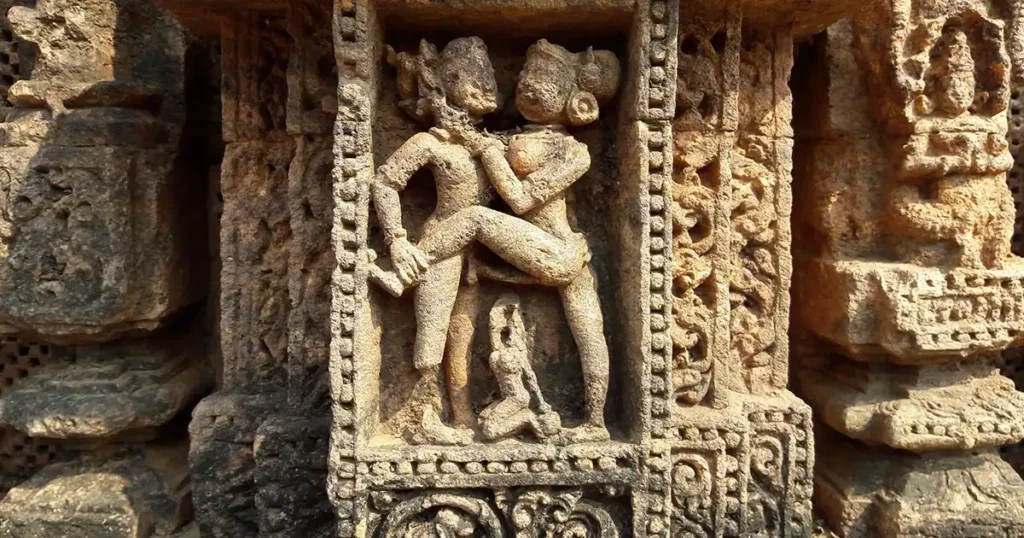
The temple is renowned for its explicit erotic sculptures known as maithunas. These intricate carvings depict various sexual acts and positions, representing fertility, life, and the celebration of human desires. These sculptures are a unique aspect of the temple’s artwork and reflect the openness of ancient Indian culture.
The temple is renowned for its exquisite stone carvings, which adorn almost every surface of the temple. The carvings depict various mythological scenes, deities, celestial beings, animals, and erotic sculptures called maithunas.
The erotic sculptures were created after the Kalinga battle. In the horrific war between Ashoka the Great and the King of Kalinga in the years 262-261 BC, more than 150,000 Kalinga warriors as well as over 100,000 of Ashoka’s own warriors perished. As a result, Kalinga was short on warriors. The population shrank significantly.
The sculptures were made to promote sex. As women frequently used to visit the temple, this could lead to sexual intercourse, resulting in childbirth.
5. Missing Main Idol
The Konark Sun Temple originally housed a massive idol of the Sun God Surya in the sanctum. However, the idol is now missing, and its exact location and fate remain unknown. It is believed that the idol was removed or destroyed during invasions and conflicts.
6. Scientific Orientation
The temple is built on an east-west axis, with the main entrance facing east. This orientation allows the first rays of the sun to enter the temple in the morning, illuminating the sanctum and creating a divine ambiance.
7. Magnificent Wheels
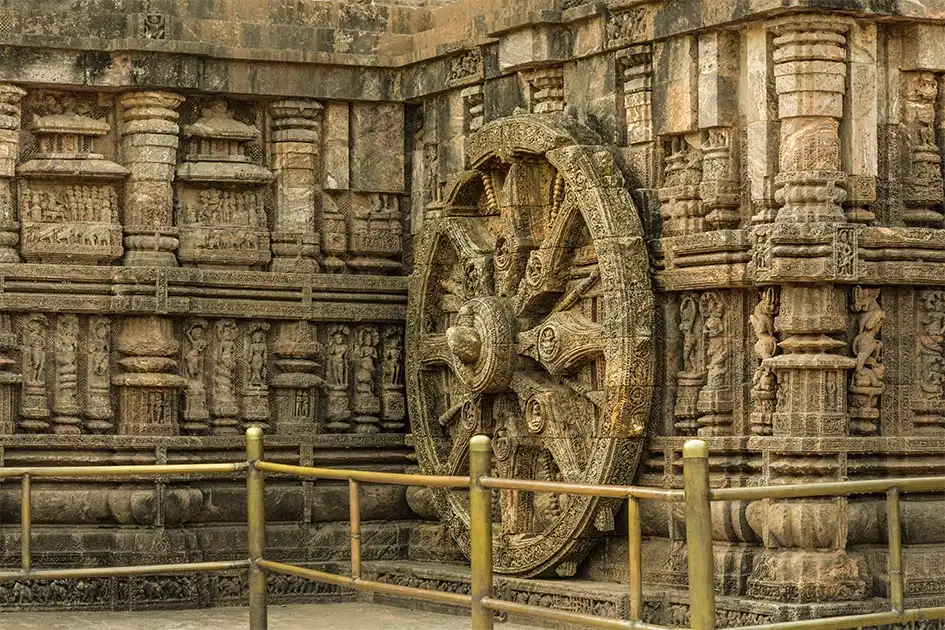
The temple’s stone wheels are not just decorative elements but also engineering marvels. Each wheel has a set of eight spokes, and the depth and spacing of the spokes create a visual effect, making them appear as if they are rotating when viewed from a distance.
8. Symbolism
The temple’s architecture symbolizes the chariot of the Sun God. The twelve pairs of intricately carved stone wheels represent the twelve months of the year, while the seven horses pulling the chariot symbolize the days of the week.
The temple’s architectural design and carvings are rich in symbolism. The sculptures depict various mythological stories, deities, celestial beings, and scenes from everyday life. They also represent cosmic principles, spiritual concepts, and the interplay of human desires and spirituality.
9. Declared National Heritage
In addition to being recognized as a UNESCO World Heritage Site, the Konark Sun Temple is also declared a national heritage monument by the Archaeological Survey of India (ASI). It is protected under the Ancient Monuments and Archaeological Sites and Remains Act of India.
10. Inspirational for Artists
The construction of the temple showcases remarkable architectural precision. The temple is designed in such a way that the first rays of the sun would pass through the main entrance and illuminate the sanctum at dawn.
The temple’s stunning architecture and intricate carvings have inspired numerous artists, architects, and scholars over the centuries. It has influenced various art forms, including classical dance, sculpture, painting, and literature.
11. It is a UNESCO World Heritage Site
The Konark Sun Temple is a designated UNESCO World Heritage Site. It was inscribed on the list in 1984, recognizing its outstanding universal value and cultural significance. The UNESCO World Heritage designation serves to protect and preserve sites of exceptional cultural or natural importance for the benefit of humanity.
The Konark Sun Temple’s inclusion as a World Heritage Site highlights its architectural brilliance, historical significance, and contribution to human civilization. The temple complex is celebrated for its exquisite stone carvings, unique architectural design, and the cultural, religious, and artistic traditions it represents.
As a UNESCO World Heritage Site, the Konark Sun Temple receives international recognition and support, promoting its conservation, research, and sustainable development. The designation also helps to increase awareness and tourism, contributing to the local economy and fostering cultural exchange.
The Konark Sun Temple’s presence on the UNESCO World Heritage list emphasizes its global significance and underscores the need for its protection and preservation for future generations to appreciate and learn from its rich cultural legacy.
12. It is Known for its Magnetism Properties
The temple was known for its unique magnetic properties, with the main tower supposedly acting as a giant magnet. This phenomenon attracted navigators, and it is believed that it caused disturbances in the compass readings of ships.
13. The Temple Complex Consists of Sanctum, Porch, and Dance Hall
The temple complex consists of the main sanctum (deul), a porch (jagamohana), and a dance hall (natya mandapa). However, the main sanctum and the jagamohana are in ruins today, while the natya mandapa is well-preserved.
14. Konark Sun Temple Suffered Damage Over the Centuries
The Konark Sun Temple, despite its grandeur, has not been spared from the ravages of time and human history.
Over the centuries, this architectural marvel has endured damage caused by a combination of natural disasters, invasions, and neglect.
From the devastating impacts of earthquakes, and erosion due to the nearby river, to the plundering by foreign invaders, the temple has witnessed the test of time and the scars of history.
The once pristine structure now stands as a reminder of the challenges faced by ancient monuments and the importance of ongoing preservation efforts to safeguard this invaluable cultural treasure.
15. The Konark Dance Festival
The Konark Dance Festival is a captivating cultural event that takes place against the backdrop of the magnificent Konark Sun Temple. Held annually in December, this festival celebrates the rich heritage of Indian classical dance forms.
Renowned dancers from across India gather at the temple complex to showcase their extraordinary talent and skill, captivating audiences with mesmerizing performances.
The festival creates a unique fusion of art, history, and spirituality, as the graceful movements of the dancers intertwine with the architectural splendor of the temple, creating a truly enchanting experience.
With the temple’s majestic beauty as the stage and the dancers as the vibrant storytellers, the Konark Dance Festival breathes new life into this ancient site, paying homage to the artistic traditions that have flourished for centuries in India.
16. The Konark Sun Temple is a Popular Tourist Destination
The Konark Sun Temple has earned its reputation as a popular tourist destination, drawing visitors from all corners of the globe. Its awe-inspiring architecture, intricate stone carvings, and historical significance make it a must-visit site for those exploring the cultural treasures of India.
Tourists are captivated by the temple’s grandeur and the stories etched into its walls, transporting them back to an era of artistic brilliance.
The serene surroundings and the temple’s proximity to the Bay of Bengal further enhance its allure. Whether it’s to marvel at the architectural marvels, immerse in the spiritual ambiance, or simply soak in the rich heritage, the Konark Sun Temple offers a unique and memorable experience for all who venture to its hallowed grounds.
The Konark Sun Temple stands as a testament to the rich heritage and artistic prowess of ancient India. It continues to captivate visitors with its architectural splendor and serves as a reminder of the country’s glorious past.
17. Sailors used the Konark Sun Temple as a landmark
Sailors historically used the Konark Sun Temple as a prominent landmark during their voyages along the eastern coast of India. The temple’s towering structure, with its distinctive chariot-like design and intricate carvings, served as a navigational guide for mariners.
The temple’s strategic location near the coast, along with its striking appearance, made it a recognizable landmark that helped sailors orient themselves and find their bearings.
This architectural marvel not only held cultural and religious significance but also played a practical role in guiding seafarers on their journeys through the vast waters of the Bay of Bengal.
18. The Konark Sun Temple Tells the Time
The architectural design of the Konark Sun Temple incorporates elements that allow it to function as a time-telling device. The temple’s positioning and intricate carvings enable it to track the movement of the sun and indicate the time of day with reasonable accuracy.
One of the most notable features is the presence of sundials on the temple’s walls. The positioning and angles of these sundials allow the temple to cast shadows that move and change throughout the day. By observing the position of these shadows, one can estimate the time, with greater precision around noon when the shadows are the shortest.
Additionally, the main entrance of the temple faces east, ensuring that the first rays of the morning sun directly illuminate the main sanctum. This alignment with the rising sun provides a natural way to mark the beginning of the day.
While the temple’s time-telling mechanism may not be as precise as modern clocks, it demonstrates the ingenuity of ancient architects in harnessing celestial movements to create functional and symbolic elements within their designs. The Konark Sun Temple’s ability to indicate the time adds to its allure and showcases the intricate relationship between architecture, astronomy, and the passage of time in ancient India.
19. The Seven Horses in The Konark Sun Temple Have Poetic Names
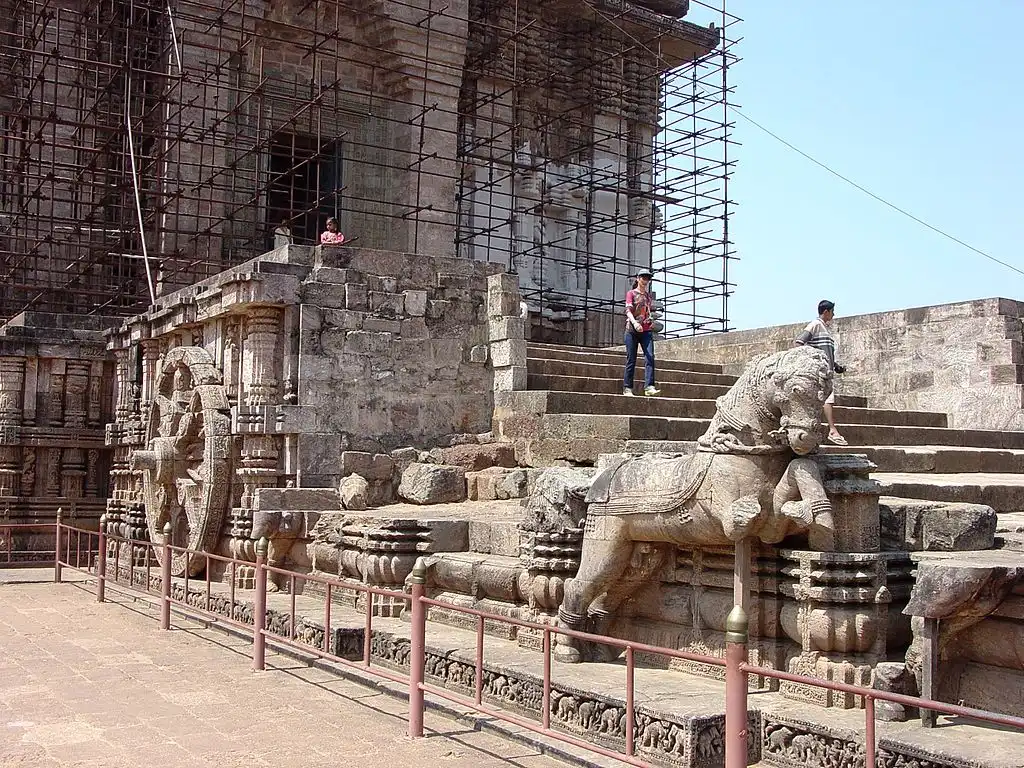
The seven horses depicted in the Konark Sun Temple are indeed named after the seven meters or “chhand” of Sanskrit poetry. Each horse represents a specific poetic meter, and their names align with the corresponding meters. The names of the horses are as follows:
- Gayatri
- Brihati
- Ushnih
- Jagati
- Trishtubha
- Anushtubha
- Pankti
These names reflect the deep connection between the artistic expressions of Sanskrit poetry and the symbolism portrayed in the architectural design of the temple.
It highlights the integration of various art forms and intellectual traditions that were prevalent during the time of the temple’s construction.
20. Archaeological Survey of India (ASI) Took Steps to Preserve the Konark Sun Temple
You are correct in stating that the Archaeological Survey of India (ASI), established in 1861, has played a crucial role in the preservation and maintenance of the Konark Sun Temple. The ASI is a government organization responsible for the protection, conservation, and study of archaeological sites and monuments throughout India.
Since its establishment, the ASI has taken significant measures to safeguard the Konark Sun Temple. They have conducted extensive documentation, research, and conservation efforts to ensure the preservation of this iconic heritage site. The ASI has implemented structural repairs, stabilizing measures, and restoration work to prevent further deterioration of the temple.
The ASI also takes measures to control environmental factors that can affect the temple, such as managing the surrounding vegetation, drainage systems, and visitor access to minimize damage to the site. Regular monitoring and maintenance activities are carried out by the ASI to ensure the structural integrity and long-term preservation of the Konark Sun Temple.
Thanks to the ongoing efforts of the ASI, visitors from around the world can continue to appreciate the grandeur and historical significance of the Konark Sun Temple, which stands as a testament to India’s rich cultural heritage.
You may also like:
- 20 Incredible Facts About Indian History
- 20 Great Indian Discoveries & Inventions
- 20 Amazing Facts About India
- 60 Mind-Blowing and Latest Facts About Indian Railways
- 10 Incredible Facts about Madhubani Paintings
Conclusion
In conclusion, the Konark Sun Temple stands as a testament to the remarkable architectural achievements of ancient India. With its rich history, deep symbolism, and intricate craftsmanship, this temple has captured the imagination of people for centuries.
Despite enduring damage from natural disasters, invasions, and neglect, it remains a captivating destination for tourists and a source of pride for the local community.
The temple’s ability to tell time, the legends associated with its construction, and its role as a cultural hub during the Konark Dance Festival all contribute to its allure.
As visitors explore its grandeur and immerse themselves in its stories, the Konark Sun Temple continues to inspire awe and reverence, allowing us to connect with the splendor of India’s artistic and spiritual heritage.
We hope you who would have enjoyed reading these amazing facts about the Konark Sun Temple. If we missed anything, put them in the comment section below.



